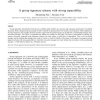Free Online Productivity Tools
i2Speak
i2Symbol
i2OCR
iTex2Img
iWeb2Print
iWeb2Shot
i2Type
iPdf2Split
iPdf2Merge
i2Bopomofo
i2Arabic
i2Style
i2Image
i2PDF
iLatex2Rtf
Sci2ools
JSS
2002
2002
A group signature scheme with strong separability
Group signatures, introduced by Chaum and van Heijst, allow members of a group to sign messages anonymously on behalf of the group. Only a designated group manager is able to identify the group member who issued a given signature. Many applications of group signatures, for example, electronic market, require that the group manager can be split into a membership manager and a revocation manager. The former is responsible for adding new members to the group. The latter is responsible for opening signatures. Previously proposed group signatures schemes can only achieve a weak form of separability. That is, the revocation manager and the membership manager must work in concert to reveal the identity of the signer. In this paper, we propose a group signature scheme with strong separability in which the revocation manager can work without the involvement of the membership manager.
| Added | 22 Dec 2010 |
| Updated | 22 Dec 2010 |
| Type | Journal |
| Year | 2002 |
| Where | JSS |
| Authors | Shundong Xia, Jinyuan You |
Comments (0)

